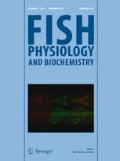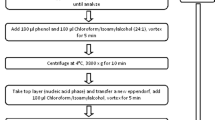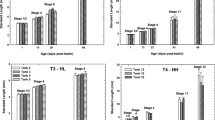Abstract
Size, caloric value and chemical composition were measured separately in the progeny of two northern pike (Esox lucius) females at 3-day intervals during the endogenous feeding period from hatching to final yolk resorption. Tissue, yolk and entire larvae were analysed separately in three groups of larvae that hatched at different times (between 88 and 106 degree-days post-fertilization). An integrated approach with the Gompertz model was used to compute the yolk conversion efficiency and time to maximum tissue size in early, mid and late hatched larvae. At hatching, unresorbed yolk of early hatched larvae contained more energy (39.20 J) and more protein (0.99 mg) compared to the yolk of larvae that hatched later (38.13 J and 0.92 mg protein for late hatched larvae, p < 0.05). In contrast, a significant reduction in tissue weight (−0.7 mg DW) and protein content (−0.5 mg) was found in early hatched larvae compared to those which hatched later (p < 0.05). Between days 9 and 12 post-hatching (108 and 144 degree-days post-hatching), close to the final yolk resorption, late hatched larvae stopped growing and their tissue began to be resorbed. This tissue resorption time was delayed in early hatched larvae which presented at the end of the experiment a greater tissue weight than late hatched ones. Yolk conversion efficiency in term of energy from hatching to complete yolk resorption stage was significantly higher for early and mid hatched larvae (51 %) compared to late hatched ones (44 %) (p = 0.004). Furthermore, the time to maximum tissue size was found to be negatively related to hatching time which implies that early hatched larvae take longer time to switch from one developmental stage to the next. The maximum tissue dry weight and energy content were found to be reached at approximately the same age post-fertilization for both early hatched and late hatched larvae, suggesting that the principal steps in a fish’s lifespan are better correlated with time of fertilization than hatching time.







Similar content being viewed by others
References
Balon EK (1981) Saltatory processes and altricial to precocial forms in the ontogeny of fishes. Am Zool 21:573–596
Balon EK (1984) Reflections on some decisive events in the early life of fishes. Trans Am Fish Soc 113:178–185
Balon EK (2001) Saltatory ontogeny and the life history model: neglected processes and patterns of evolution. J Bioecon 3:1–26
Balon EK (2002) Epigenetic processes, when natura non facit saltum becomes a myth, and alternative ontogenies a mechanism of evolution. Environ Biol Fish 65:1–35
Baras E, d’Almeida AF (2001) Size heterogeneity prevails over kinship in shaping cannibalism among larvae of sharptooth catfish Clarias gariepinus. Aquat Living Res 14:251–256
Baras E, Maxi MYJ, Ndao M, Melard C (2000) Sibling cannibalism in dorada under experimental conditions. II. Effect of initial size heterogeneity, diet and light regime on early cannibalism. J Fish Biol 57:1021–1036
Baras E, Kestemont P, Melard C (2003) Effect of stocking density on the dynamics of cannibalism in sibling larvae of Perca fluviatilis under controlled conditions. Aquaculture 219:241–255
Calow P (1977) Conversion efficiencies in heterotrophic organisms. Biol Rev 52:385–409
Ciuhandu CS, Stevens ED, Wright PA (2005) The effect of oxygen on the growth of Oncorhynchus mykiss embryos with and without a chorion. J Fish Biol 67:1544–1551
Dawirs RR (1981) Elemental composition (C, N, H) and energy in the development of Pagurus bernhardus (Decapoda: Paguridae) megalopa. Mar Biol 64:117–123
DeAngelis DL, Rose DA, Crowder LB, Marschall EA, Lika D (1993) Fish cohort dynamics: application of complementary modeling approaches. Am Nat 142:604–622
Desvilettes C, Bourdier G, Breton JC (1997) Lipid class and fatty acid composition of planktivorous larval pike Esox lucius living in a natural pond. Aquat Living Resour 7:67–77
Eckmann R (1987) A comparative study on the temperature dependence of embryogenesis in three coregonids (Coregonus spp.) from lake Constance. Swiss J Hydrol 49(3):353–362 (in French, with a summary in English)
Edmondson WT, Winberg GG (1971) A manual on methods for the assessment of secondary productivity in fresh waters. Blackwell, Oxford
Ferron A, Leggett WC (1994) An appraisal of condition measures for marine fish larvae. Adv Mar Biol 30:217–303
Finn RN (2007) The physiology and toxicology of salmonid eggs and larvae in relation to water quality criteria. Aquat Toxicol 8:337–354
Fuiman LA, Werner RG (2002) Fishery science: the unique contributions of early life stages. Blackwell Science, Oxford
Geffen AJ (2002) Length of herring larvae in relation to age and hatching order. J Fish Biol 60:479–485
Gnaiger E, Bitterlich G (1984) Proximate biochemical composition and caloric content calculated from elemental CHN analysis: a stoichiometric concept. Oecologia 62:289–298
Green BS, Anthony KRN, McCormick MI (2006) Position of egg within a clutch is linked to size at hatching in a demersal tropical fish. J Exp Mar Biol Ecol 329:144–152
Haliloğlu Hİ, Aras NM, Yanık T, Atamanalp M, Kocaman EM (2003) Investigation of changes in fatty acid composition at early development stages of rainbow trout (Oncorhynchus mykiss). Turk J Vet Anim Sci 27:1105–1109
Hamor T, Garside ET (1979) Hourly and total oxygen consumption by ova of Atlantic salmon, Salmo salar L. in various combinations of temperature and dissolved oxygen. Can J Zool 57:1196–1200
Hardy RS, Litvak MK (2004) Effects of temperature on the early development, growth and survival of shortnose sturgeon Acipenser brevirostrum and Atlantic sturgeon Acipenser oxyrhynchus yolk-sac larvae. Environ Biol Fish 70:145–154
Heming TA (1982) Effects of temperature on utilization of yolk by chinook salmon (Oncorhynchus tshawytscha) eggs and alevins. Can J Fish Aquat Sci 39:184–190
Heming TA, Buddington RK (1988) Yolk absorption in embryonic and larval fishes. In: Randall DJ, Hoar WS (eds) Fish physiology volume XI, San Diego, p 407
Ivanova MN, Svirskaya AN (2009) Growth and feeding of juvenile pike Esox lucius (Esocidae) of different hatching dates during its first months of life. J Ichthyol 49:516–526
Jaworski A, Kamler E (2002) Development of a bioenergetics model for fish embryos and larvae during the yolk feeding period. J Fish Biol 60:785–809
Kamler E (1992) Early life history of fish. An energetics approach. Chapman and Hall, London
Kamler E (2008) Resource allocation in yolk-feeding fish. Rev Fish Biol Fisher 18:143–200
Kamler E, Kato T (1983) Efficiency of yolk utilization by Salmo gairdneri in relation to incubation temperature and egg size. Pol Arch Hydrobiol 30:271–306
Kamler E, Szlamińska M, Hamáčková J, Kouřil J, Vachta R, Stibranyiová I, Muñoz Asenjo C (1995) Growth and metabolism during development of tench (Tinca tinca (L.)) embryos and larvae at 22°C. Pol Arch Hydrobiol 42:97–108
Kennedy J, Geffen AJ, Nash RDM (2007) Maternal influences on egg and larval characteristics of plaice (Pleuronectes platessa L.). J Sea Res 58:65–77
Kestemont P, Jourdan S, Houbart M, Melard C, Paspatis M, Fontaine P, Cuvier A, Kentouri M, Baras E (2003) Size heterogeneity, cannibalism and competition in cultured predatory fish larvae: biotic and abiotic influences. Aquaculture 227:333–356
Klekowski RZ, Duncan A (1975) Physiological approach to physiological energetic. In: Grodziński W, Klekowski RZ, Duncan A (eds) Methods for ecological bioenergetics. Blackwell Scientific Publishing, Oxford, pp 15–64
Korwin-Kossakowski M (2008) The influence of temperature during the embryonic period on larval growth and development in carp, Cyprinus carpio L. and grass carp, Ctenopharyngodon idella (Val.): theoretical and practical aspects. Arch Pol Fish 16:231–314
Laurel BJ, Hurst TP, Copeman LA, Davis MW (2008) The role of temperature on the growth and survival of early and late hatching Pacific cod larvae (Gadus macrocephalus). J Plankton Res 30:1051–1060
Methven DA, Brown JA (1991) Time of hatching affects development, size, yolk volume, and mortality of newly hatched Macrozoarces americanus (Pisces: Zoarcidae). Can J Zool 69:2161–2167
Miller BS, Kendall AW (2009) Early life history of marine fishes. University of California Press, Berkeley
Monroy A, Ishida M, Nakano E (1961) The pattern of transfer of the yolk material to the embryo during the development of the teleostean fish Oryzias latipes. Embryol 6:151–158
Ninness MM, Stevens ED, Wright PA (2006) Removal of the chorion before hatching results in increased movement and accelerated growth in rainbow trout (Oncorhynchus mykiss) embryos. J Exp Biol 209:1874–1882
Overnell J (1997) Temperature and efficiency of development during endogenous feeding in herring embryos and yolk-sac larvae. J Fish Biol 50(2):358–365
Pannevis MC, Houlihan DF (1992) The energetic cost of protein synthesis in isolated hepatocytes of rainbow trout (Oncorhynchus mykiss). J Comp Physiol 162:393–400
Peňáz M (1983) Ecomorphological laws and saltation in the early ontogeny of Salmonoidei. Folia Zool 32(4):365–373
Porter SM (2001) Effects of size and light on respiration and activity of walleye pollock (Theragra chalcogramma) larvae. J Exp Mar Biol Ecol 256:253–265
Porter SM, Bailey KM (2007) The effect of early and late hatching on the escape response of walley pollock (Theragra chalcogramma) larvae. J Plankton Res 29:291–300
Quelet R (1961) Précis de chimie. Tome III: Chimie organique. Presses universitaires de France, France
Rønnestad I, Finn RN, Lein I, Lie Ø (1995) Compartmental changes in the contents of total lipids, lipid classes and their associated fatty acids in developing yolk-sac larvae of Atlantic halibut, Hippoglossus hippoglossus (L.). Aquacult Nutr 1:119–130
Schnute J (1981) A versatile growth model with statistically stable parameters. Can J Fish Aquat Sci 38:1128–1140
Smith RW, Houlihan DF (1995) Protein synthesis and oxygen consumption in fish cells. J Comp Physiol 165:93–101
Steenfeldt S, Lund I, Höglund E (2011) Is batch variability in hatching time related to size heterogeneity and cannibalism in pikeperch (Sander lucioperca)? Aquacult Res 42:727–732
Trabelsi A, Gardeur JN, Teletchea F, Brun-Bellut J, Fontaine P (2013) Hatching time effect on the intra-spawning larval morphology and growth in Northern pike (Esox lucius L.). Aquacult Res 44:657–666
Wieser W, Forstner H, Medgyesy N, Hinterleitner S (1988) To switch or not to switch: partitioning of energy between growth and activity in larval cyprinid (Cyprinidae: Teleostei). Funct Ecol 2:499–507
Yamagami K (1988) Mechanisms of hatching in fish. In: Hoar WS, Randall DJ (eds) Fish physiology. Academic Press, San Diego, pp 447–499
Acknowledgments
The authors would like to thank Helen Dobby for her contribution to this work.
Author information
Authors and Affiliations
Corresponding author
Rights and permissions
About this article
Cite this article
Trabelsi, A., Jaworski, A., Kamler, E. et al. The effect of hatching time on the bioenergetics of northern pike (Esox lucius) larvae from a single egg batch during the endogenous feeding period. Fish Physiol Biochem 42, 593–606 (2016). https://doi.org/10.1007/s10695-015-0162-6
Received:
Accepted:
Published:
Issue Date:
DOI: https://doi.org/10.1007/s10695-015-0162-6




